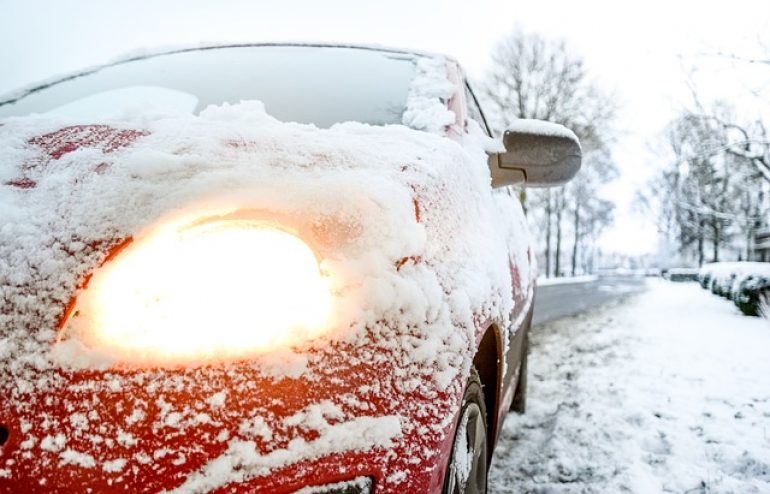With storms Dylan and Eleanor hitting the country over the Christmas and New Year period, high winds, heavy rain, snow and ice meant drivers faced treacherous travel conditions on the roads and a rise in vehicles and their passengers being stranded at the roadside. These wintry conditions are set to stay and with the inevitable Storm Fionn brewing we’ve put together a helpful guide on preparing for your journey, driving safely in severe weather conditions and how to keep safe in the unfortunate event of a breakdown.
It is always advisable to avoid driving in heavy rain, snow or ice if your journey is not necessary. However, if you do need to make the journey here are some tips you can follow to help stay safe on the road and reduce the risk of a breakdown;
Driving in heavy rain
Before you set off: expect delays and congestion, so give yourself more time. Check that your windscreen wipers are working and that your tyres have enough tread.
Breakdowns: are more common in the rain as wet weather can cause engine problems and other technical issues, so make sure you have the appropriate level of motor breakdown cover and the details in the car. Ensure your mobile is fully charged.
Stopping speeds: these will be impaired by at least double when the roads are wet so drive slowly and make sure you keep a safe distance from the car in front.
Reduced visibility: keep your car heating on to prevent windows from misting up and watch out for spray from passing vehicles.
Skidding on water: avoid braking or braking hard, ease off the accelerator and try to regain control.
Driving through water: even just a few inches of water can cause serious damage to your car.
Driving in snow and ice
Before you set off: expect delays and congestion, so give yourself more time. Ensure you take food, water, blankets, a torch, a first aid kit, a fully charged phone, a shovel, jump leads and de-icer fluid. Make sure you have a full tank of fuel, and check the oil and other engine fluids. Make sure you clear all your windows as it’s illegal (and very unsafe) to drive if you can’t see out of all of them! Clear your bonnet and roof of snow too to avoid snow being blown onto your windscreen from your bonnet or worse sliding onto your windscreen from your roof under heavy braking.
Plan your route: if possible try to stick to major roads which should have been gritted
Keep your distance: it can take 10 times as long to come to a stop in icy conditions compared to normal. Remember to drive smoothly and don’t brake or accelerate harshly, otherwise your tyres will lose grip. If you do skid, don’t brake take your foot off the accelerator and let the car slow down itself.
Be aware: keep distractions to a minimum, the radio turned off or down low so you can hear the difference if you hit an icy patch.
If you do breakdown, follow these tips to keep you safe whilst you wait for breakdown assistance;
Make sure you’re in a safe place.
If possible, move your vehicle off the road (making sure you avoid soft verges). If you’re on a motorway try and turn off at the next exit, if this is not possible pull up onto the hard shoulder. Try and stop as far to the left as you can, with the wheels turned to the left.
Put your hazard warning lights on and if it’s dark or foggy, keep your sidelights on too.
Stay well away from moving traffic. It’s usually safest to get out of your car (using the doors facing away from passing traffic) and wait behind a barrier. If you’re on a motorway, move up the bank if you can. Leave animals in the car.
If you have a reflective jacket, wear it so you are other drivers can see you.
If it’s safe to do so on the road you are on, put a warning triangle at least 45m (50 yards) behind your vehicle but it’s not safe to put a warning triangle on the hard shoulder if you’re on a motorway.
Call your breakdown company, even attempting a simple repair especially if you are on a motorway could be extremely dangerous. Have your motor breakdown policy details ready with your location and any other information which may be relevant.
If you’re on a motorway and don’t have a mobile or its battery is drained, there are free emergency phones that will connect you straight to the police or the Highways Agency these are located on your side of the carriageway at one-mile intervals. Follow the arrows on the posts keeping to the back of the hard shoulder. Always face the traffic when you speak on the phone. Give as many details as you can – including your location – and inform the Highways Agency or police if you are a vulnerable motorist such as disabled, travelling alone, older, or with small children.
If you have reason to feel at risk from another person whilst waiting, get into the vehicle – from the left-hand side – and lock all the doors and if necessary call the police.

